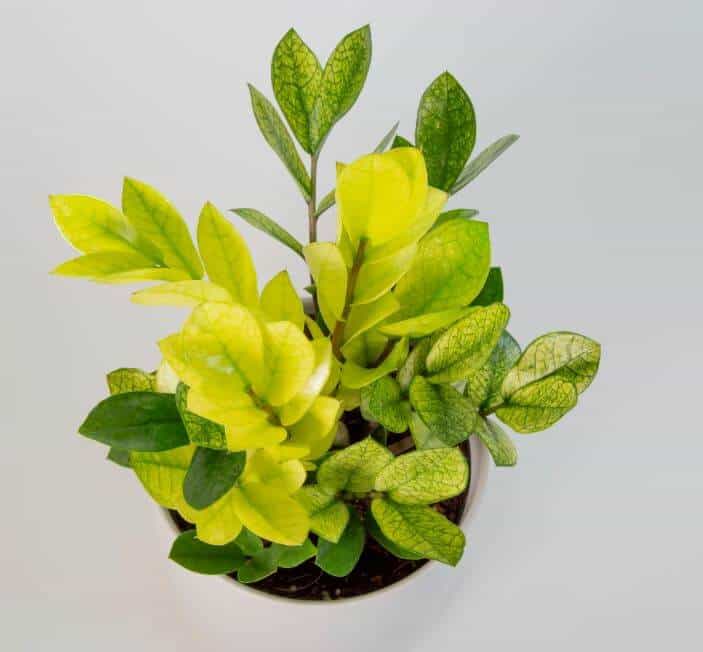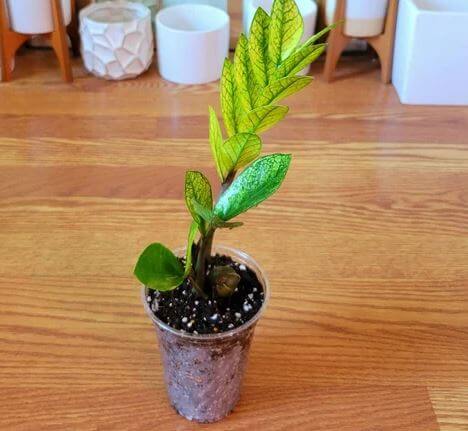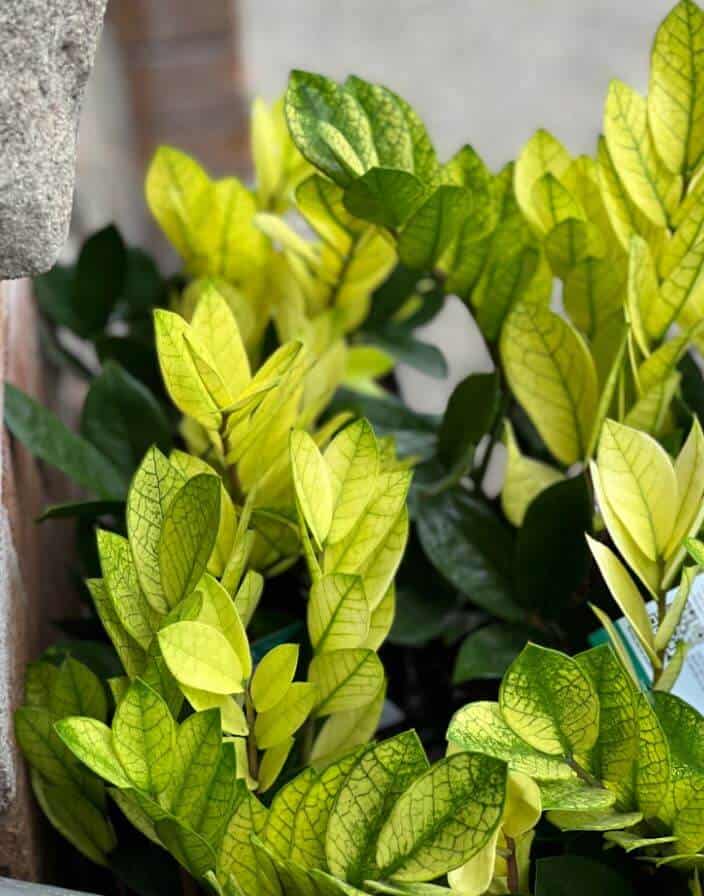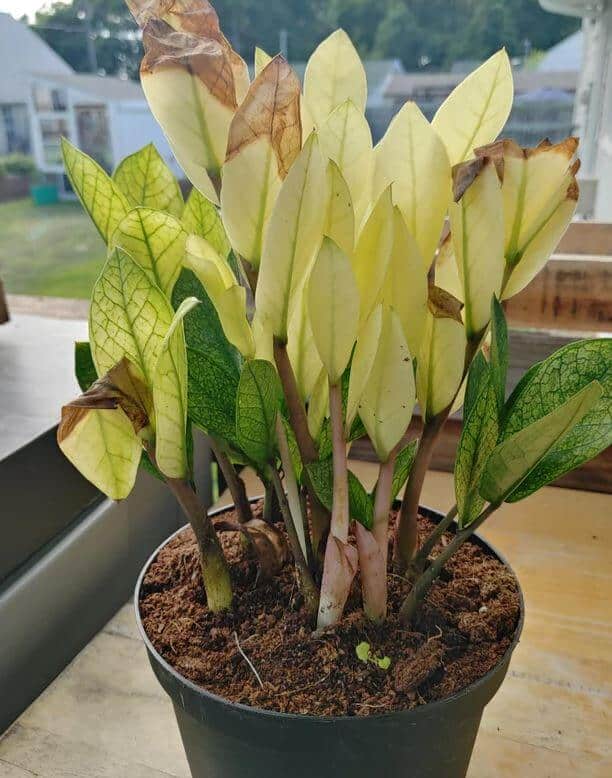Last Updated on January 5, 2023 by a Friendly Gardener
If you are not a fan of the ZZ plant, you should be especially if you live in an apartment with little natural light or want a plant for a windowless office. The ZZ plant is also ideal for those that travel or don’t have lots of time to dedicate to plant care. Adaptable to low light, low humidity, and very little watering, it is a truly easy-to-care-for houseplant.
For those who know and love the Zamioculcas zamiifolia, there’s a beautiful, uncommon variety called the Chameleon ZZ plant.
Belonging to the Araceae family, the Chameleon ZZ plant is striking because new growth appears as a bright yellow and will gradually turn to a deep dark green as it matures, you’ll enjoy variations in foliage color as your plant grows.
ZZ plants are usually cultivated as indoor houseplants unless you live in an area free of frost where it can be grown outdoors in partial shade. The ZZ species is native to Eastern Africa where it is drought tolerant, making it ideal for plant parents that forget to water. Slow growing, it can grow from 2 to 3 feet as a container plant, but with extra care can even become a floor plant reaching heights of 5 feet.
Chameleon ZZ Plant Care

The Chameleon ZZ plant, like other ZZ cultivars, can manage with a thorough soaking every 2 to 3 weeks and medium-light to thrive. Glossy oval leaves account for their attractiveness, but they are dust magnets, so a good weekly dusting will keep them shining. Avoid using leaf shine sprays as they can clog pores and harm the plant.
Soil

A good quality potting mix is fine for ZZ plants as long as good draining is guaranteed. Make sure your pot has a sufficient number of drainage holes and add perlite or sand to the potting mix to ensure drainage.
Light
The chameleon ZZ plant will adapt to low light conditions, but it appreciates a location that offers medium light or yet even better, bright indirect light. Never place this plant in direct sunlight as this will scorch the foliage. The Chameleon ZZ can be cultivated with either natural or plant grow lights successfully. If the light is insufficient, your plant may appear leggy as it reaches a light source. Rotate your plant every several days for even growth.
Water
The Chameleon ZZ is a low-water plant thanks to the fact that it uses its thick foliage as well as its tubular rhizomes to store water explaining why it is drought tolerant. To encourage the ZZ Chameleon to produce those new golden yellow leaves, water this plant when the soil bed feels approximately 50% dry. This may be every several weeks depending on your home’s climate.
In locations with more light, you may water more frequently while in low-light conditions you will water less. If you are unsure, it’s better to wait than risk overwatering as this cultivar prefers being dry. Have any doubts get a moisture meter. This is one reason a Chameleon ZZ plant is great for travelers; it can last without water.
Humidity
The Chameleon ZZ does not need high humidity levels to survive or thrive. Average office or home humidity levels will suffice.
Temperature
As a drought-tolerant plant from Africa, household temperatures will suffice for your plant. ZZ cultivars do not appreciate the cold, so temperatures should not fall below 45°F. Avoid placing your Chameleon ZZ in the path of drafts by positioning it far enough away from doors, windows, and vents.
Feeding
Not a hungry houseplant, the Chameleon ZZ will find sufficient nutrients in the soil bed. Still, you can treat your ZZ plant to occasional fertilization during the growing season with a liquid 20-20-20 NPK fertilizer added when watering so that it is adequately diluted. Limit fertilization to once or twice a season.
Pruning

Your Chameleon ZZ will not require pruning except if you need to remove old foliage. Intrusive stems can be trimmed if desired.
Repotting the Chameleon ZZ Plant

You can repot this cultivar when it outgrows its actual container. You’ll know the plant’s rhizomes need more space if your pot begins to look misshapen due to the rhizomes pressing against the sides. If you do repot, do so in the springtime or the summer season.
Chameleon ZZ Plant Propagation
Generally speaking, ZZ plants are propagated using plant division, or by taking stem cuttings. Dividing the rhizomes when you repot is the simplest method, and each rhizome should be planted in its own new pot.
Propagation using stem cuttings requires cutting a stem segment with a minimum of two leaves and placing it in soil. The pot should then be located in a warm spot with bright indirect light exposure. This is a slower propagation method that usually requires 6 to 9 months for a new rhizome to develop fully.
The Chameleon ZZ plant cultivar has been patented with code PP32.253P3 so it really should not be propagated.
Chameleon ZZ Plant Toxicity
All ZZ plant cultivars, including the Chameleon ZZ plant, are toxic to family dogs and cats, and to humans. All plant parts contain calcium oxalate crystals with sharp edges that irritate the skin if touched or ingested. If you have a Chameleon ZZ that looks as if it has been chewed on, watch family pets for signs of excessive drooling or vomiting. In the event of breathing difficulties, contact a vet immediately.
Chameleon ZZ Plant Problems

ZZ plants generally resist pest infestations, nonetheless, the occasional visit by mites, whiteflies, mealybugs, aphids, or gnats is not unheard of. Treat your Chameleon ZZ with a diluted Neem oil spray if you note any evidence of pests.
While the Chameleon ZZ is drought tolerant, it does need water to survive. If the plant begins to wilt or the foliage appears wrinkled, it needs a good soaking.
If the soil bed appears soggy and leaves are yellowing or mushy, you are drowning your plant. Repot immediately in fresh soil and wait a week or two before watering anew.
Chameleon ZZs that begin to bend may be reaching for a light source. Change your plant’s location to one with a bit more light.
The Chameleon ZZ plant distinguishes itself because the new foliage is a bright yellow. The key here is new foliage. If the entire plant becomes yellow or mature foliage begins yellowing, your plant may be suffering from root rot due to overwatering or be suffering from a lack of nutrients. It might also be too rootbound. In any of these cases, you will need to repot.

